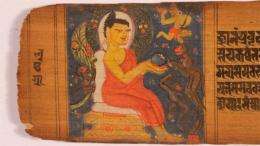Powerful words

Ancient manuscripts that hold important clues to India’s intellectual and religious traditions will be the focus of a new study.
A major exercise in ‘linguistic archaeology’ has set out to complete a comprehensive survey of Cambridge University Library’s South Asian manuscript collection, which includes the oldest dated and illustrated Sanskrit manuscript known worldwide.
Written on now-fragile birch bark, palm leaf and paper, the 2,000 manuscripts in the collection express centuries-old South Asian thinking on religion, philosophy, astronomy, grammar, law and poetry.
The project, which is led by Sanskrit-specialists Dr. Vincenzo Vergiani and Dr. Eivind Kahrs and funded by the Arts and Humanities Research Council, will study and catalogue each of the manuscripts, placing them in their broader historical context. Most of the holdings will also be digitised by the Library and made available through the Library’s new online digital library ().
“In a world that seems increasingly small, every artefact documenting the history of ancient civilisations has become part of a global heritage to be carefully preserved and studied,” explained Dr. Vergiani, who is in the University’s Faculty of Asian and Middle Eastern Studies. “Among such artefacts, manuscripts occupy a distinctive place – they speak to us with the actual words of long-gone men and women, bringing their beliefs, ideas and sensibilities to life.”
He added: “One reason this collection is so important is because of the age of many of the manuscripts. In the heat and humidity of India, materials deteriorate quickly and manuscripts needed to be copied again and again. As a result, many of the early Indian texts no longer exist.”
In fact, some of the oldest holdings of the Library’s South Asian collection were discovered not in India but in Nepal, where the climate is more temperate. In the 1870s, Dr. Daniel Wright, surgeon of the British Residency in Kathmandu, rescued the now-priceless cultural and historical artefacts from a disused temple, where they had survived largely by chance.
An early catalogue of part of the collection in 1883 found among its treasures a 10th-century Buddhist Sanskrit manuscript from India – the oldest dated and illustrated Sanskrit manuscript known worldwide.
More than half of the collection is in Sanskrit, a language that has dominated the literary culture of pre-modern South Asia for almost three millennia. Its earliest attestations are found in the Vedic hymns (texts that are still central to Hinduism), dating from the end of the second millennium BC.
“The word Sanskrit means refined or perfected. From a very early stage, its speakers were obsessed with handing down their sacred texts intact,” said Dr. Vergiani. “Out of this developed an attention to how the language works. A grammatical tradition arose that produced, around the 4th century BC, the work of Pāṇini, an amazing intellectual achievement and arguably the beginning of linguistics worldwide, which made the language constant, stable and transmissible.”
It is this robustness that Dr. Vergiani believes explains how the language became so prevalent across South Asia – a situation that has been likened to the spread of Latin across Europe: “It was used by religious figures and royalty, scholars and scientists, administrators and artists. Well into modern times, Sanskritic culture was very much alive throughout India, and the language is still used by a number of intellectuals and religious figures today.”
The widespread use of Sanskrit as the language of power and communication across South Asia makes the collection at the Library so significant. The manuscripts, written in centuries that spanned momentous political and economic change, are an invaluable and untapped source for understanding the pre-colonial past of South Asia, and therefore its present.
By combining traditional philological methods with advanced information technology, the project will make these extraordinary documents available in new ways, helping to further research on the intellectual traditions, religious cults, literature and political ideas of South Asia.
Provided by University of Cambridge




















